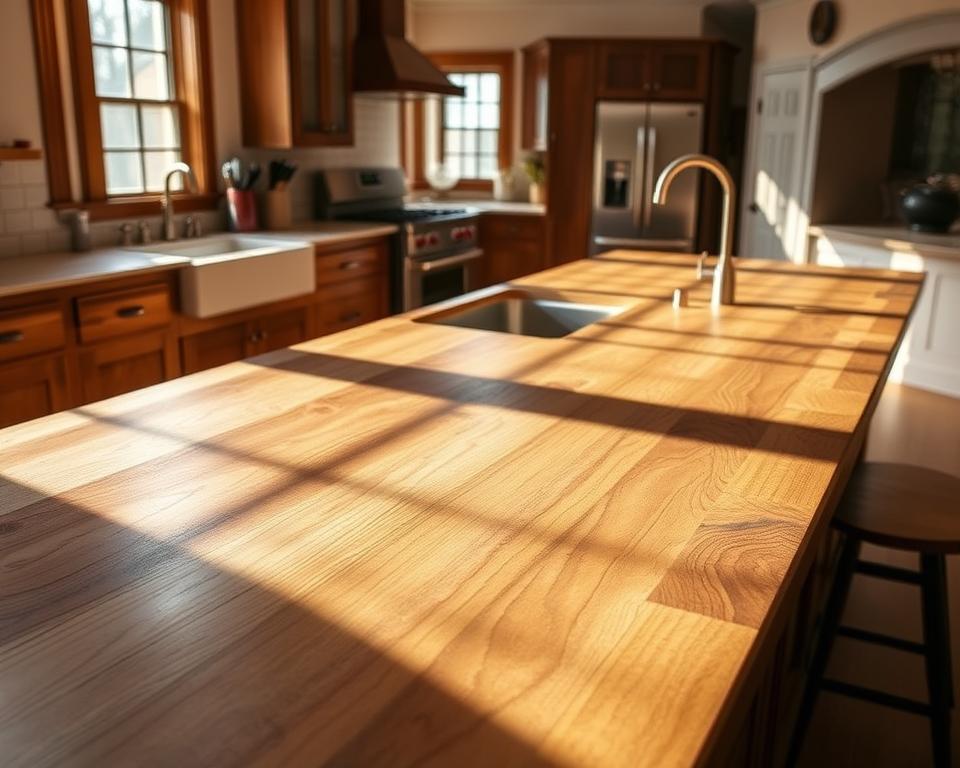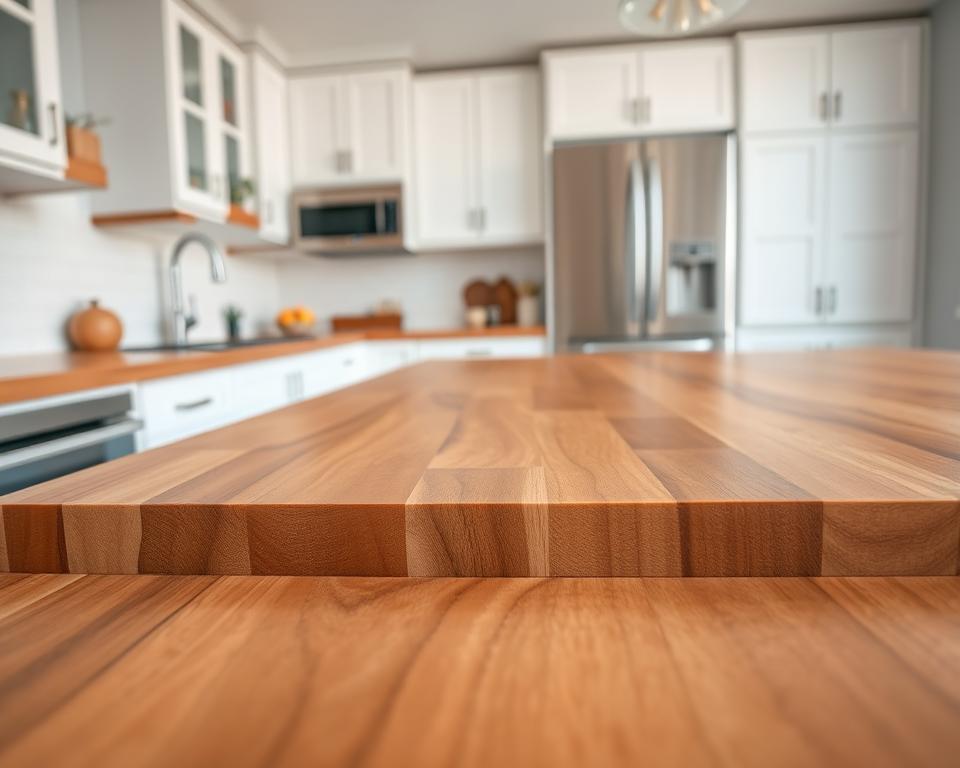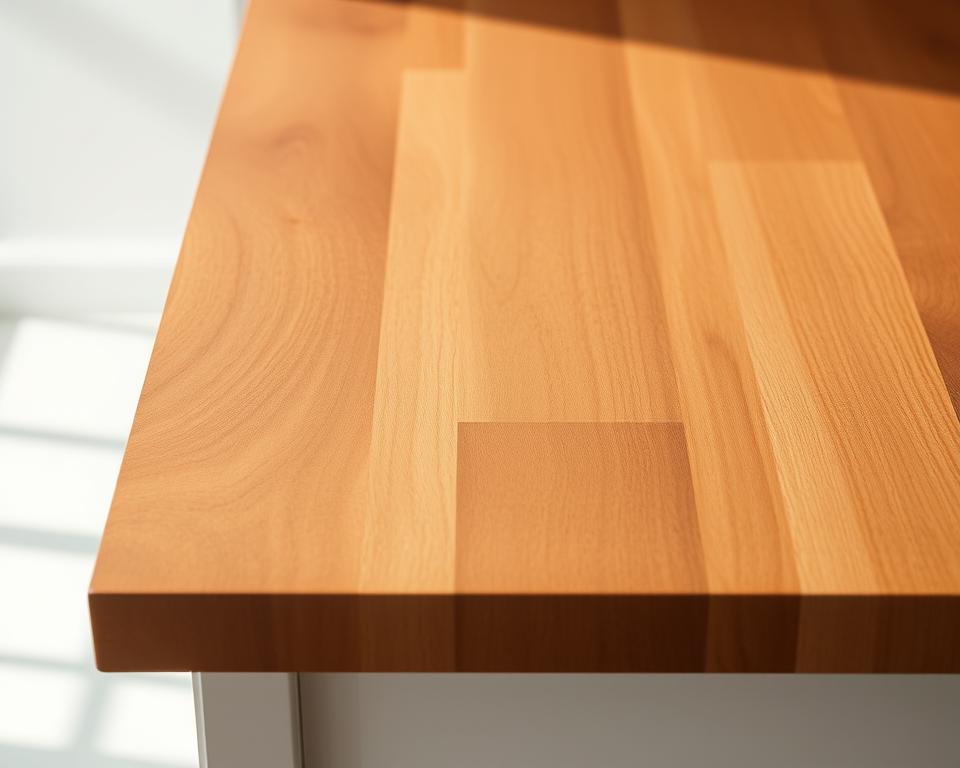Butcher block countertops are a favorite in kitchens for their affordability and durability. Constructed from glued-together wood pieces, they offer a robust surface that endures for years with care. You can pick from maple, oak, and walnut, among others, to find the ideal butcher block countertop for your kitchen’s aesthetic.
Compared to granite or quartz, butcher block countertops are more budget-friendly but pricier than laminate. Their construction from glued wood ensures a long-lasting surface. To keep them in top condition, regular sealing with mineral oil is essential, done monthly to ward off moisture.
Introduction to Butcher Block Countertops
Butcher block countertops are gaining traction among homeowners who desire natural, functional kitchen surfaces. Maple, walnut, cherry, hickory, and oak are common woods used, each bringing its own color and grain to the table. Their versatility allows for a broad spectrum of natural wood hues, ranging from light blonde to deep chocolate.
Key Takeaways
- Butcher block countertops are a durable and affordable option for kitchens.
- Wood butcher block is made from straight pieces of wood glued together.
- Kitchen butcher block countertops can last for many years with proper maintenance.
- Regular maintenance includes sealing with mineral oil once a month.
- Butcher block countertops are available in various wood types and colors.
- They can be paired with other materials, such as soapstone, for a unique look.
What Are Butcher Block Countertops?
Butcher block countertops have long been a favorite in kitchens, prized for their durability and simple upkeep. With the right maintenance for butcher block countertops, they can endure for decades. They offer a stunning and practical surface for food prep.
Choosing the best butcher block countertops involves several considerations. The type of wood, grain, and finish all play crucial roles. Various hardwoods, like maple, oak, and cherry, are used, each bringing its own set of advantages.
History and Origin of Butcher Block
The history of butcher block countertops is deeply rooted in woodworking’s early days. Initially, they served as cutting boards. Over time, they’ve become a staple in kitchen countertops.
Modern Uses and Applications
In today’s kitchens, butcher block countertops cater to both traditional and modern aesthetics. They can be combined with materials like stainless steel and granite. This combination creates a space that’s both unique and practical. With the right maintenance for butcher block countertops, they can remain a key feature of your kitchen for many years.
Benefits of Butcher Block Countertops
Butcher block countertops combine durability, aesthetic appeal, and cost-effectiveness, making them a favorite among homeowners. When searching for where to buy butcher block countertops, focus on high-quality materials and expert installation. Custom butcher block countertops can be tailored to suit any kitchen style, from modern to traditional.
Durability and Longevity
Butcher block countertops are renowned for their durability and longevity, lasting up to 20 years with proper care. They resist scratches and stains well, making them ideal for active kitchens.
Aesthetic Appeal and Versatility
The natural beauty of butcher block countertops brings warmth and character to kitchens. They can be combined with various materials and designs, offering versatility for custom kitchens. Whether you desire a traditional or modern look, butcher block countertops can be stained or finished to suit your taste.
Cost-Effectiveness Compared to Other Materials
Butcher block countertops are more affordable than granite or quartz but pricier than laminate. Yet, their durability and longevity make them a cost-effective choice over time. With the right maintenance, butcher block countertops can endure for years, proving to be a wise investment for your kitchen.
Different Types of Wood for Butcher Block
Choosing the right wood for your butcher block countertop is crucial. The wood type impacts the countertop’s durability and look, as well as the butcher block countertop installation process.
Popular options include maple, oak, and walnut. These woods are durable and resistant to scratches and stains. They are perfect for butcher block countertop care.
Popular Wood Choices
- Maple: A favorite for its light color and toughness, with a Janka Hardness rating of 1450.
- Oak: Strong and versatile, with a Janka Hardness score of 1300.
- Walnut: Ideal for a darker, richer appearance.
Considerations for Wood Selection
When picking wood for your countertop, think about durability, upkeep, and cost. Proper butcher block countertop care extends its life. The right wood choice also affects the butcher block countertop installation process.
By selecting the correct wood and following care and installation guidelines, you’ll have a beautiful, functional butcher block countertop for years.
Maintenance Tips for Butcher Block Countertops
To maintain your affordable butcher block countertops, regular care is crucial. Wipe down the surface after each use and clean spills immediately. For a deeper clean, mix warm water with gentle dish soap. Regularly applying mineral oil protects the wood from moisture and stains.
When maintaining butcher block countertops, remember a few key points. Use a food-grade mineral oil that is colorless, odorless, and tasteless. This oil is available at local drugstores or hardware stores. Also, use an old washcloth for cleaning and a rag for oiling, promoting eco-friendly practices.
Butcher block countertops are ideal for those seeking low maintenance. They need routine cleaning with soap and water or just water. Oil them a few times a year. With proper care, they can age beautifully and retain their charm for years. Consider using mineral oil and beeswax (board butter) as an alternative conditioner. Sand the countertop lightly before the first oil and wax application to remove debris.
By adhering to these maintenance tips, your butcher block countertops will stay in top condition. They will remain a beautiful and functional kitchen feature for years. Whether you’re looking for affordable options or just want to maintain your countertops, these tips are a great starting point.
How to Install Butcher Block Countertops
Installing butcher block countertops can be a DIY endeavor, but it demands the right tools and expertise. Butcher block countertop installation requires meticulous planning and execution for a proper and safe setup. The steps include measuring, cutting, and assembling the countertop, followed by applying finishes and sealants.
A custom butcher block countertops installation is complex. It’s advisable to seek professional assistance if you’re not confident in the process. Yet, with the correct tools and guidance, you can create a stunning and functional butcher block countertop installation. This will undoubtedly elevate your kitchen’s look and functionality.
Key aspects of butcher block countertop installation include leaving a 1/8-inch expansion gap along walls. Use pocket hole jigs to secure pieces together. Also, apply multiple coats of sealant to safeguard the wood. Choosing a food-safe sealer is crucial if the countertop will be used for food preparation.
By adhering to these guidelines, you can successfully install custom butcher block countertops. This will ensure years of service and enjoyment. Always prioritize safety and use the appropriate tools and materials for a proper and safe installation.
Butcher Block Countertops vs. Other Materials
Choosing the right material for your kitchen countertop is crucial. Butcher block countertops stand out due to their affordability and durability. For the best butcher block countertops, focus on the wood type and finish. Look for where to buy butcher block countertops locally or online to find the perfect match.
Compared to granite and quartz, butcher block is more budget-friendly and offers a natural aesthetic. Yet, it demands regular care to avoid scratches and stains. Here’s a detailed comparison:
| Material | Cost | Durability | Maintenance |
|---|---|---|---|
| Butcher Block | $1,600 (30 sq ft) | High | Regular oiling |
| Granite | $3,000 (30 sq ft) | Very High | Periodic sealing |
| Quartz | $2,500 (30 sq ft) | High | Low maintenance |
Your choice of countertop material should align with your needs and preferences. By weighing the pros and cons of each, you can make a well-informed decision. This will help you find the ideal countertops for your kitchen.
Creative Ways to Use Butcher Block in Your Kitchen
Butcher block countertops are versatile, extending beyond traditional kitchen uses. They can be creatively integrated into your kitchen, enhancing its aesthetic. With the right butcher block countertop care, these surfaces can endure for a long time. Consider using custom butcher block countertops for kitchen islands and breakfast bars.
This approach not only adds counter space but also warms up your kitchen. Butcher block can also adorn your walls as shelves or pot racks, elevating your kitchen’s elegance and sophistication.
- Kitchen islands with built-in sinks or cooktops
- Breakfast bars with stools or seating areas
- Wall-mounted shelves or pot racks
- Custom dining tables with butcher block tops
Integrating butcher block into your kitchen design allows for a space that’s both unique and functional. It showcases your personal style. With proper butcher block countertop care, your custom countertops will remain stunning and durable for years.
Colors and Finishes for Butcher Block Countertops
Choosing the right butcher block countertop involves more than just picking a material. The color and finish play a crucial role in enhancing your kitchen’s look and feel. Homeowners can find a style that matches their decor and maintenance preferences. For those on a budget, natural finishes are a favorite for their unique, organic appearance.
Butcher block countertops come in various finishes, from the raw beauty of natural wood to the vibrant hues of stained surfaces. Natural finishes highlight the wood’s natural charm, while stained options introduce color and flair. In 2023, expect to see a rise in neutral shades like beige and gray, alongside bolder choices like blue and red. Keeping your countertops well-maintained is key to preserving their beauty and longevity.
- Maple: a light, neutral wood that works well with modern kitchen styles
- Walnut: a dark, rich wood that adds a touch of sophistication to traditional kitchens
- Oak: a classic, versatile wood that suits a range of kitchen styles
By selecting the ideal color and finish, homeowners can craft a kitchen that is both aesthetically pleasing and practical. With the right care and maintenance for butcher block countertops, these surfaces can endure for many years. They offer a durable, stylish option for kitchens of every style.
Budgeting for Your Butcher Block Countertop Project
Planning to install butcher block countertops requires a clear understanding of the costs. The average price per square foot ranges from $30 to $40, as reported by The Spruce. Yet, prices can fluctuate based on wood type, size, and installation fees. For those seeking butcher block countertops, online platforms or local hardware stores are viable options.
Several factors influence the overall cost:
- Type of wood: Different woods impact the price.
- Size: Larger countertops require more material, raising costs.
- Installation costs: Labor fees apply if you hire professionals.
Custom butcher block countertops, with their unique designs and craftsmanship, come at a premium. Yet, with proper care, they can endure for decades, proving a valuable addition to your kitchen.
Grasping the cost dynamics and exploring purchase options helps in budget-conscious decision-making. This approach ensures you stay within your financial limits.
Real-Life Examples of Butcher Block Countertops
When thinking about upgrading your kitchen with butcher block countertops, it’s motivating to see their impact in real homes. They’ve been used in everything from classic farmhouse kitchens to contemporary, minimalist designs. This versatility and durability make them a standout choice.
Inspiring Kitchen Transformations
The Smith family’s kitchen is a prime example. Their maple butcher block countertop adds warmth and invites you in. Despite their active household, the best butcher block countertops have stood the test of time. Their ease of upkeep and refinishing capabilities have made them a favorite in their home.
Customer Testimonials and Reviews
Those who’ve chosen butcher block countertop care have shared their joy. Sarah, a homeowner from California, loves how her butcher block countertops enhance her kitchen’s farmhouse vibe. She finds the surface incredibly resilient, and a simple mineral oil treatment keeps it looking vibrant.
FAQ
What are butcher block countertops?
What is the history and origin of butcher block countertops?
What are the modern uses and applications of butcher block countertops?
What are the benefits of butcher block countertops?
What are the different types of wood used for butcher block countertops?
How do I maintain my butcher block countertop?
Can I install butcher block countertops myself?
How do butcher block countertops compare to other materials?
What are the current color and finish trends for butcher block countertops?
How much do butcher block countertops cost?
Where can I find real-life examples and customer reviews of butcher block countertops?

Tina Moore is a writer at TrendGaping, dedicated to farmhouse decor and rustic minimalism. With a love for natural textures and vintage charm, she explores topics like distressed wood finishes, cozy interiors, and functional yet stylish design. Her goal is to help readers create warm, inviting spaces that reflect the beauty of country living.



